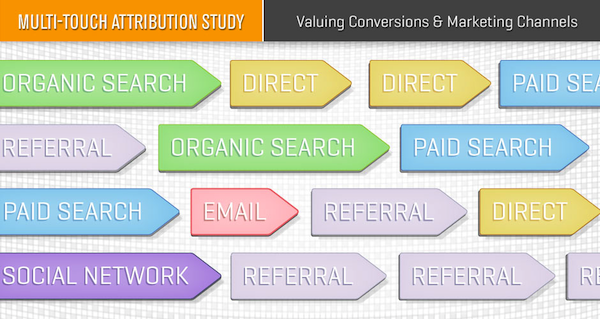
First or last-touch attribution models may result in companies seriously over or undervaluing specific marketing channels, according to Indianapolis-based firm SlingshotSEO. In the largest study of its kind, the SEO service company analyzed more than 23 million multiple-interaction conversions across 30 domains over a period of one year. Based on their findings, they’ve released a step-by-step guide to multi-touch attribution.
In first and last-touch attribution models, marketers give credit to only one referral source for each conversion. In reality, consumers may take several steps in discovering, researching, considering and buying a product or service.
Multi-touch attribution helps marketers consider all aspects of the path to conversion, enabling them to make better business and budget decisions based on how consumers find and buy. In flat multi-touch attribution, all channels (organic, paid search, social, etc.) are weighted equally.
In their examination of enterprise-level client conversions, Slingshot SEO found that:
- Organic search was undervalued by as much as 77.25 percent
- Paid advertising and referrals were also undervalued in most cases.
- Direct visits were overvalued by as much as 81.59 percent
“Google Analytics just released multi-channel funnels last year, so people may not be aware of how to use this, Evan Fishkin, Head of Research & Development, told Search Engine Watch. “We did a flat model and divided each channel out evenly, but you can change those parameters.”
You should weight channels according to your business needs, Fishkin recommends. It is a necessity to look at all interactions rather than just the last touch, in order to allot the proper percentage of your budget to each channel.
Organic is often undervalued, Slingshot suggests, because it is nearer the top of the funnel and functions more as a research vessel. Users took 2.79 actions before converting, they note, with a branded keyword search or direct visit often the last action. However, they had completed their initial research at that point and were ready to buy.
Direct Visits Universally Overvalued; Organic Undervalued by 77.25 Percent

SlingshotSEO’s research spanned sites in a number of industries, including Retail, Home & Garden, Finance & Insurance, Health & Wellness, Business & Industrial, and Computers & Consumer Electronics.
Interestingly, organic search and non-branded organic search were undervalued across the board, by all 30 test subjects (domains). Multi-touch attribution showed that “organic search” should have been worth as much as 77.25 percent more than previously thought, and “non-branded organic” should have been worth as much as 81.59 percent more.
Direct visits, meanwhile, were overvalued on all 30 test sites and should have been worth as much as 35.74 percent less. An overvalued marketing channel means that budget allotted to that avenue might be better spent on another. Conversely, an undervalued channel presents an opportunity for better utilization and increased revenue if its potential is realized.
Top 20 Most Common Conversion Paths

These are the most common paths taken to conversion (in paths with more than two steps) during the study, though they don’t shine any light on user behavior or motivation. Rather, says the report, “The table is helpful because it outlines which overall paths are most likely to be taken by a user without having to apply a multi-touch model to break out the values between each individual channel.”
The report also notes there are numerous paths beyond those in the top 20; this simply “speaks to the need for the quantitative analysis from a multi-touch model to prioritize channels more effectively.”
How to Implement a Multi-Touch Model
Fishkin and study co-author statistician Casey Szulc break down the multi-touch attribution model on pages three to five of the study. They offer a step-by-step process marketers can implement to take advantage of the more accurate data available within Google Analytics.
The goal is to compare conversions (last-touch) with attributed conversions (flat multi-touch) for a specific channel, according to Slingshot. Their instruction will show you how to do just that. If you have the time, said Szulc, always do your analysis based on this model.
Fishkin recommends marketers reevaluate at least quarterly.
“It depends on the size of the business; if you’re only getting 100 visitors every 3 months, you’re probably not receiving the amount of data to allow you to make good business decisions,” he said. “Evaluate campaigns as often as your business requirements demand.”
You can download the full report and guide from Slingshot’s Resources page.


